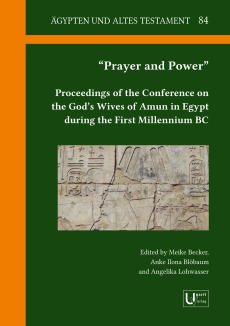“Prayer and Power“
Anthology by Egyptologists Becker, Blöbaum and Lohwasser on God’s Wives in ancient Egypt

The God’s wives of Amun in the 1st mill. BC are in the focus of a recent publication, edited by Meike Becker, Anke Ilona Blöbaum and Angelika Lohwasser, members of the Cluster of Excellence “Religion and Politics”. „The God’s Wives were the highest priestesses as well as political authorities in Thebes during the 1st millennium BC”, explains Prof. Dr. Angelika Lohwasser, who investigates the Nubian God’s Wives. Main topics of the study are the individual God’s wives and especially the interdependency between the religious office and the political reality – i.e. dynastic quarrels and a royal residence far from Thebes.
The anthology „Prayer and Power. Proceedings of the Conference on the God’s Wives of Amun in Egypt during the First Millennium BC“ has been recently released by Ugarit-Verlag. It unites contributions of an international conference held in Münster in 2015.
Religious, political and medial aspects
The God’s Wife of Amun was the highest-ranking priestess in Ancient Egypt. While this important religious office was already centered in Thebes during the early New Kingdom (about 1550 BC), it became less important later because of the religious changes in the Amarna-Period.
During the 10th-8th century BC the office of the God’s Wife of Amun was revived, and in the following 200 years (8th-6th century BC) the institution gained religious, political and economic influence. The God’s wife – a daughter of the reigning king – was supposed to remain unmarried and adopt a daughter of a next king as her heiress. Therefore, the choice of the sacerdotal successor had a political dimension.
As the royal palace and capital was in the northern part of Egypt, the God’s Wife acted as the substitute for the king in the southern part of Egypt. She took a royal titulary with names in two cartouches. Furthermore, she had the authority to build chapels in Karnak and mortuary edifices in Medinet Habu. As the head of Theban theocracy, she controlled one of the largest economic centers in Egypt of that time. Within this economic network, she integrated the top-level families of the Theban aristocracy. However, her major duty was her active involvement in the temple ritual: she was performing offerings in front of Amun. Moreover, she participated in rituals that asserted the king’s territorial authority as well as Amun’s universal power. On the occasion of festivals, she played an active role during processions as an intermediary between god and humankind.
The contributions to this anthology focus on the heyday of the institution of the God’s Wives of Amun in Egypt during the Third Intermediate Period as well as the early Late Period. They address the influence of individual God’s wives in contrast to the influence of femininity in general. Above all, questions concerning their artistic representation, different religious, political and social aspects of the God’s Wives of Amun and their building activities are discussed in several articles.
Prof. Dr. Angelika Lohwasser is head of the project B2-12 „The Semantics of Change: Self-Affirmation, Propaganda, and Magic in the Visual Language of Egypt in the Early First Millennium B.C.“ and is member of the interconnecting platform F “Transcultural Entanglements” and the coordinated project group “Figurations of the religious and the political”. (exc/maz)

